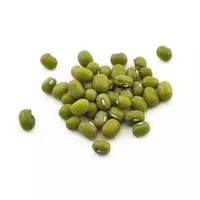Peas mash

Mung peas or beans, as well as golden beans, are the names of a plant that fit perfectly into the national oriental cuisine. At the same time, in China, it is not only eaten, but also actively used the beneficial properties of mung peas. Externally, it is a small oval-shaped green bean that is smooth to the touch and has an attractive glossy sheen.
Indians have long cultivated this perennial plant - it was they who gave the name to the mung peas, which sounds like mung in Hindi. Therefore, in fact, the historical homeland of this pea is the territory of India, Pakistan and Bangladesh. However, it is currently cultivated on an industrial scale in China, Thailand, Indonesia, the Phillip Islands, Myanmar, as well as throughout the subtropical belt of the globe. In southern Europe, as well as some US states, where climatic conditions are quite dry, these legumes are also grown. Moreover, the harvest is collected in 2 stages: the first time in June, and the second - in November.
In the cuisine of Central and Southeast Asia, India, Japan and Korea, mash peas have found a wide range of applications. Chinese culinary experts mainly either cook the beans whole, or peel, grind, and then simmer the mash with spices and seasonings. The small beans need to be cooked for about 40 minutes and do not need to be soaked beforehand. The taste of mash peas is very similar to the taste of beans, but with a barely tangible nutty tint. It is often used as a side dish for a variety of meat dishes or added mash to soups. By the way, mash, deep-fried, is considered an unusually tasty Eastern snack.
Light green peeled mash peas act as the main ingredient used in the preparation of Indian dhal paste. It is used as an additional component of all kinds of desserts, creams and pancakes. Dhal is also present in some types of ice cream, drinks and jelly.
Mash leaves an unusually enchanting aftertaste when consumed with palm sugar. In addition, it can decorate the aroma and taste of dishes together with ginger and garlic. And if you combine these legumes with vegetables, sauces, peanuts, seafood, chicken or beef, the result is very tasty and satisfying snacks and salads.
In the production of some types of noodles and jelly, mash pea starch is used. A vegetarian pilaf called mash khurda, which is made from rice, unpeeled mash and vegetable oil, is extremely popular in Uzbekistan.
peas mash 300 kKal
Energy value of peas mash (Ratio of proteins, fats, carbohydrates - ju):
Proteins: 23.5 g (~ 94 kCal)
Fats: 2g (~ 18kCal)
Carbohydrates: 46g (~ 184kCal)
Energy ratio (bj | y): 31% | 6% | 61%
 Español
Español Français
Français Português
Português Русский
Русский 简体中文
简体中文 繁體中文
繁體中文 日本語
日本語 한국어
한국어 العربية
العربية Türkçe
Türkçe Қазақ
Қазақ Deutsch
Deutsch Italiano
Italiano Українська
Українська
